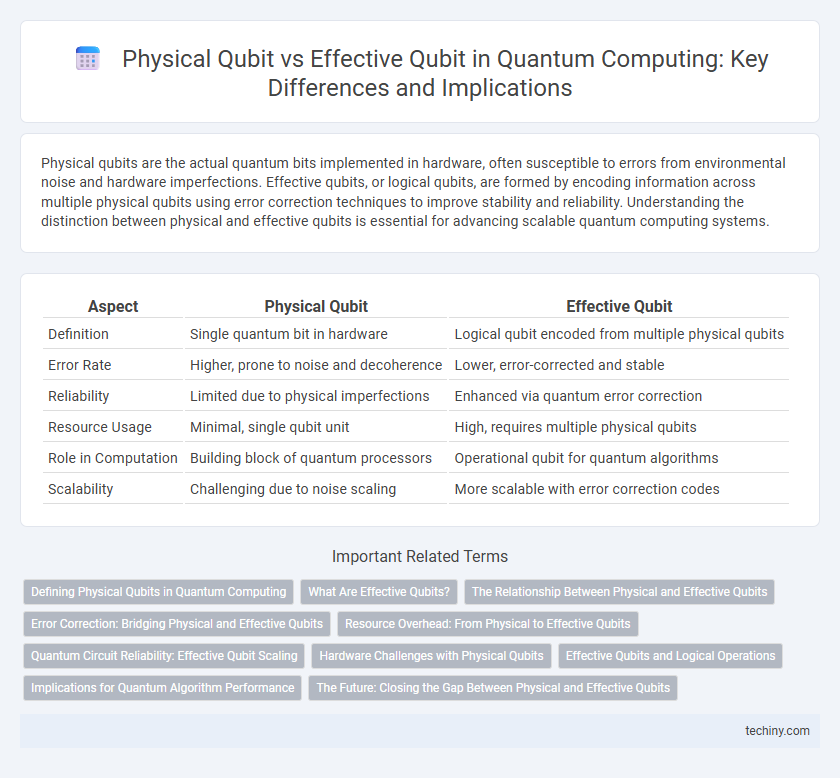Physical qubits are the actual quantum bits implemented in hardware, often susceptible to errors from environmental noise and hardware imperfections. Effective qubits, or logical qubits, are formed by encoding information across multiple physical qubits using error correction techniques to improve stability and reliability. Understanding the distinction between physical and effective qubits is essential for advancing scalable quantum computing systems.
Table of Comparison
| Aspect | Physical Qubit | Effective Qubit |
|---|---|---|
| Definition | Single quantum bit in hardware | Logical qubit encoded from multiple physical qubits |
| Error Rate | Higher, prone to noise and decoherence | Lower, error-corrected and stable |
| Reliability | Limited due to physical imperfections | Enhanced via quantum error correction |
| Resource Usage | Minimal, single qubit unit | High, requires multiple physical qubits |
| Role in Computation | Building block of quantum processors | Operational qubit for quantum algorithms |
| Scalability | Challenging due to noise scaling | More scalable with error correction codes |
Defining Physical Qubits in Quantum Computing
Physical qubits in quantum computing refer to the actual hardware elements, such as superconducting circuits or trapped ions, that embody quantum bits through controlled quantum states. These qubits undergo real-world decoherence and error rates that directly impact computational fidelity. Effective qubits represent error-corrected logical qubits, where multiple physical qubits are combined to mitigate noise and increase operational reliability.
What Are Effective Qubits?
Effective qubits represent the actual computational resources available in a quantum computer after accounting for error rates and qubit coherence times, differing from physical qubits which are the raw hardware units. They measure the quality and reliability of quantum information processing by incorporating error correction overhead and gate fidelity. Understanding effective qubits is critical for assessing the true performance potential of quantum processors beyond mere physical qubit counts.
The Relationship Between Physical and Effective Qubits
Physical qubits serve as the fundamental hardware units in quantum computers, but their susceptibility to errors necessitates error correction to form effective qubits. Effective qubits represent logical qubits created through quantum error correction codes, enhancing stability and reliability by encoding multiple physical qubits into a single error-resistant unit. The ratio between physical and effective qubits, often termed overhead, is critical for scaling quantum systems, impacting computational power and fault tolerance.
Error Correction: Bridging Physical and Effective Qubits
Error correction techniques in quantum computing transform multiple noisy physical qubits into fewer, more reliable effective qubits, enhancing computational stability. Physical qubits are susceptible to decoherence and operational errors, necessitating complex error-correcting codes like surface codes to preserve quantum information. Effective qubits represent logical qubits encoded across many physical qubits, enabling scalable quantum algorithms with improved fault tolerance and reduced error rates.
Resource Overhead: From Physical to Effective Qubits
Physical qubits serve as the fundamental hardware units in quantum computers but are prone to errors and decoherence, necessitating error correction protocols that dramatically increase the number of qubits required. Effective qubits, also called logical qubits, result from encoding multiple physical qubits through quantum error correction codes, leading to significant resource overhead commonly quantified by the ratio of physical to logical qubits. This overhead often demands hundreds or thousands of physical qubits to realize a single reliable effective qubit, highlighting a major challenge in scaling quantum computing hardware.
Quantum Circuit Reliability: Effective Qubit Scaling
Physical qubits represent the actual quantum bits in hardware, but due to noise and errors, the effective qubit count is often lower, reflecting the reliable qubits available for computation. Quantum circuit reliability depends on error correction protocols, which scale the effective qubit number by encoding logical qubits across multiple physical qubits. Achieving higher effective qubit scaling enhances circuit fidelity, enabling more complex quantum algorithms and improving the overall performance of quantum processors.
Hardware Challenges with Physical Qubits
Physical qubits rely on fragile quantum states that are highly sensitive to environmental noise, causing decoherence and operational errors which limit their coherence time and gate fidelity. Hardware challenges include managing cross-talk between qubits, maintaining ultra-low temperature environments with dilution refrigerators, and addressing fabrication variability in superconducting circuits or trapped ions. Effective qubits, often realized through quantum error correction codes, require multiple physical qubits to construct a logical qubit capable of fault-tolerant computation, significantly increasing hardware complexity.
Effective Qubits and Logical Operations
Effective qubits represent the logical qubits encoded within physical qubits to enhance error correction and computational stability in quantum computing. Logical operations on effective qubits utilize quantum error-correcting codes, such as the surface code, to perform fault-tolerant gate implementations that mitigate decoherence and operational errors. The distinction between physical and effective qubits is critical for scalable quantum systems, enabling reliable quantum algorithms despite hardware imperfections.
Implications for Quantum Algorithm Performance
Physical qubits, prone to errors and decoherence, limit quantum algorithm reliability due to imperfect gate operations and noise interference. Effective qubits, representing logical qubits encoded through quantum error correction, enhance algorithm performance by maintaining coherence and reducing error rates. The ratio of physical to effective qubits directly impacts the scalability and practical implementation of complex quantum algorithms.
The Future: Closing the Gap Between Physical and Effective Qubits
Advancements in quantum error correction and qubit coherence times are pivotal to closing the gap between physical qubits and effective qubits, enabling more reliable quantum computations. Increasing the fidelity of physical qubits directly enhances the scalability and performance of quantum processors by reducing error rates and improving logical qubit stability. Emerging materials and noise-resilient architectures are key factors driving progress toward practical quantum advantage through more efficient use of effective qubits.
physical qubit vs effective qubit Infographic

 techiny.com
techiny.com